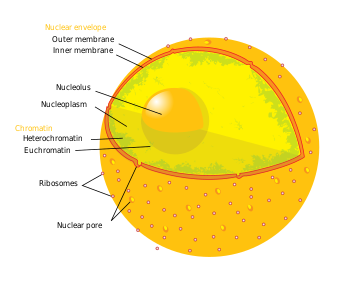The nuclear envelope (NE) (also known as the perinuclear envelope, nuclear membrane, nucleolemma or karyotheca) is a double lipid bilayer that encloses the genetic material in eukaryotic cells. The NE serves as the physical barrier, separating the contents of the nucleus (DNA in particular) from the cytosol (cytoplasm).
Numerous nuclear pores are inserted in the nuclear envelope and facilitate and regulate the exchange of materials (proteins such as transcription factors, and RNA) between the nucleus and the cytoplasm.
Each of the two membranes is composed of a lipid bilayer. The outer membrane is continuous with the rough endoplasmic reticulum while the inner nuclear membrane is the primary residence of several inner nuclear membrane proteins. The outer and inner nuclear membrane are fused at the site of nuclear pore complex insertion.The inner nuclear membrane is connected to the nuclear lamina, a network of intermediate filaments composed of various lamins (A, B1, B2, & C). The lamina acts as a site of attachment for chromosomes and provides structural stability to the nucleus. The lamins have been associated with various genetic disorders collectively termed laminopathies.
The nuclear envelope has two membranes, each with the typical unit membrane structure. They enclose a flattened sac and are connected at the nuclear pore sites. The outermost membrane is continuous with the rough endoplasmic reticulum (ER) and has ribosomes attached (see figure to the left). The space between the outer and inner membranes is also continuous with rough endoplasmic reticulum space. It can fill with newly synthesized proteins just as the rough endoplasmic reticulum does. The nuclear envelope is enmeshed in a network of filaments for stability.
The nuclear envelope is shown in an electron micrograph in the figure to the right. The filaments outside the envelope are not visualized with these protocols. Also, the nuclear lamina just inside the nuclear envelope is not shown well (see paragraph below for description). However, one can see ribosomes on the outer membrane and the sac enclosed by the two membranes. Dense patches of Heterochromatin are seen just inside the inner membrane.
The space between the two membranes that make up the nuclear envelope is called the perinuclear space (also called the perinuclear cisterna, NE Lumen), and is usually about 20 - 40 nm wide.
The nuclear envelope has been postulated to play a role in the organization and transcriptional activity of chromatin.
Nuclear envelope breakdown during mitosis in metazoans
During prophase in mitosis, the chromatids begin condensing to form chromosomes, and the nuclear envelope breaks down and is retracted into the mitotic endoplasmic reticulum. At metaphase, the nuclear envelope has been completely disassembled and absorbed by the ER allowing the chromosomes to be pulled apart by spindle fibers attached to each chromosome at the kinetochore. Other eukaryotes such as yeast undergo closed mitosis, where the chromosomes segregate within the nuclear envelope, which then buds as the two daughter cells divide.












No comments:
Post a Comment